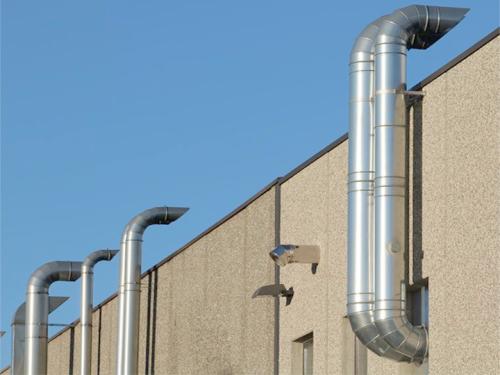通风管道规格区分:从细节处辨明差异
来源:http://www.jntfgd.com 日期:2025-07-04 发布人:创始人
区分不同规格的通风管道,需从尺寸参数、材质特性、结构形式等多维度综合判断,这些差异直接影响其适用场景与通风效果,掌握区分方法能为选型、安装与维护提供精准依据。
Distinguishing ventilation ducts of different specifications requires comprehensive judgment from multiple dimensions such as size parameters, material characteristics, and structural forms. These differences directly affect their applicable scenarios and ventilation effects. Mastering the differentiation method can provide accurate basis for selection, installation, and maintenance.
尺寸是区分通风管道规格的基础指标,主要看截面尺寸与长度。常见的矩形管道以 “宽 × 高” 表示规格,如 200mm×100mm、400mm×200mm 等,宽度与高度的比例通常不超过 4:1,避免因形状过扁影响气流稳定性;圆形管道则以直径标注,如 φ150mm、φ300mm,直径越大,单位时间内的通风量越大(相同风速下,φ300mm 管道的风量约是 φ150mm 的 4 倍)。长度方面,标准直管段多为 3 米或 6 米,特殊定制管道可根据工程需求调整,但过长会增加安装难度与气流阻力。测量时需注意,尺寸指的是管道内径(圆形)或内边距(矩形),而非包含保温层的外径,这直接关系到与其他设备的对接精度。
Size is the basic indicator for distinguishing the specifications of ventilation ducts, mainly based on the cross-sectional size and length. Common rectangular pipes are expressed in terms of "width x height", such as 200mm x 100mm, 400mm x 200mm, etc. The ratio of width to height is usually not more than 4:1 to avoid affecting airflow stability due to their flattened shape; Circular pipes are marked with diameters, such as 150mm and 300mm. The larger the diameter, the greater the ventilation volume per unit time (at the same wind speed, the air volume of a 300mm pipe is about four times that of a 150mm pipe). In terms of length, standard straight pipe sections are mostly 3 meters or 6 meters. Special customized pipelines can be adjusted according to engineering needs, but being too long will increase installation difficulty and airflow resistance. When measuring, it should be noted that the size refers to the inner diameter (circular) or inner edge (rectangular) of the pipeline, not the outer diameter including the insulation layer, which directly affects the docking accuracy with other equipment.
材质特性是区分规格的另一重要标志,不同材质对应不同使用场景。镀锌钢板管道表面有均匀的锌层,用磁铁可吸附(铁磁性),适用于干燥、无腐蚀性的环境(如办公楼、商场),厚度通常为 0.5-1.2mm,厚度越大承重与抗风压能力越强;不锈钢管道无磁性(304 材质)或弱磁性(430 材质),表面光滑耐锈蚀,多用于厨房排烟、化工车间等有油烟或腐蚀性气体的场所,厚度一般 1.0-2.0mm;玻璃钢管道质地坚硬、颜色多为灰色,无磁性,适用于潮湿或有酸碱的环境(如地下车库、实验室),其厚度根据压力等级而定(低压管道壁厚 3-5mm,高压可达 8-10mm)。通过观察外观(镀锌板的锌花、不锈钢的光泽、玻璃钢的纹理)和简单测试(磁性、硬度),可快速区分材质规格。
Material properties are another important indicator for distinguishing specifications, and different materials correspond to different usage scenarios. Galvanized steel pipes have a uniform zinc layer on the surface, which can be adsorbed by magnets (ferromagnetic) and are suitable for dry, non corrosive environments (such as office buildings and shopping malls). The thickness is usually 0.5-1.2mm, and the thicker the thickness, the stronger the load-bearing and wind pressure resistance ability; Stainless steel pipes are non-magnetic (304 material) or weakly magnetic (430 material), with a smooth and rust resistant surface. They are commonly used in places with oil fumes or corrosive gases such as kitchen smoke exhaust and chemical workshops, with a thickness of 1.0-2.0mm. Fiberglass pipes are hard in texture, mostly gray in color, non-magnetic, and suitable for humid or acidic environments (such as underground garages and laboratories). Their thickness depends on the pressure level (the wall thickness of low-pressure pipes is 3-5mm, and high-pressure pipes can reach 8-10mm). By observing the appearance (zinc flower on galvanized sheet, luster of stainless steel, texture of fiberglass) and conducting simple tests (magnetism, hardness), material specifications can be quickly distinguished.

结构形式的差异也能体现管道规格,主要体现在连接方式与加固措施上。螺旋风管(圆形)的接缝呈螺旋状,密封性好,常用于大直径、长距离通风(直径可达 1600mm);矩形风管多为法兰连接,法兰材质与管道一致(如镀锌法兰配镀锌管道),法兰间距根据风压设定(低压≤1.5 米,高压≤1.0 米)。当管道尺寸超过一定标准(如矩形风管长边≥630mm、圆形直径≥800mm),会增加加固筋或楞线,防止风压过大导致变形,加固间距随尺寸增大而减小(如 1000mm 直径的圆形管道,加固间距≤1.5 米)。此外,柔性风管(如铝箔伸缩管)的规格以直径和伸缩长度表示(如 φ200mm×5m),多用于设备与硬质管道的连接,可通过拉伸长度调节安装距离。
The differences in structural forms can also reflect the specifications of pipelines, mainly reflected in the connection methods and reinforcement measures. The seams of spiral ducts (circular) are spiral shaped and have good sealing performance. They are commonly used for large diameter and long-distance ventilation (with a diameter of up to 1600mm); Rectangular air ducts are mostly connected by flanges, and the flange material is consistent with the pipeline (such as galvanized flanges with galvanized pipes). The flange spacing is set according to the wind pressure (low pressure ≤ 1.5 meters, high pressure ≤ 1.0 meters). When the size of the pipeline exceeds a certain standard (such as rectangular ducts with a long side ≥ 630mm and circular ducts with a diameter ≥ 800mm), reinforcement bars or ridges will be added to prevent deformation caused by excessive wind pressure. The reinforcement spacing decreases with increasing size (such as circular ducts with a diameter of 1000mm, reinforcement spacing ≤ 1.5 meters). In addition, the specifications of flexible air ducts (such as aluminum foil expansion pipes) are expressed in diameter and expansion length (such as φ 200mm × 5m), which are mostly used for connecting equipment with hard pipes and can be adjusted by stretching the installation distance.
压力等级是隐藏的规格参数,需结合用途判断。低压管道(压力≤500Pa)多用于普通通风(如办公室新风),管壁较薄,法兰连接可采用铆接;中压管道(500Pa<压力≤1500Pa)适用于排烟、除尘(如车间通风),需采用螺栓连接法兰,密封垫厚度≥3mm;高压管道(压力>1500Pa)用于高风压场景(如矿井通风),管壁厚度比同尺寸中压管道厚 0.2-0.5mm,法兰需加劲肋增强强度。压力等级可通过管道上的标识(如喷涂的 “P≤500Pa”)或配套的风机参数间接判断,这直接关系到安装时的密封要求与安全标准。
The pressure level is a hidden specification parameter that needs to be judged based on its intended use. Low pressure pipelines (pressure ≤ 500Pa) are mostly used for ordinary ventilation (such as office fresh air), with thin pipe walls, and flange connections can be riveted; Medium pressure pipelines (500Pa<pressure ≤ 1500Pa) are suitable for smoke exhaust and dust removal (such as workshop ventilation), and require bolted flange connections with a sealing gasket thickness of ≥ 3mm; high-pressure pipelines (pressure>1500Pa) are used in high-pressure scenarios (such as mine ventilation), with a wall thickness of 0.2-0.5mm thicker than medium pressure pipelines of the same size, and flanges need to be reinforced with ribs to enhance strength. The pressure level can be indirectly determined by the markings on the pipeline (such as the sprayed "P ≤ 500Pa") or the matching fan parameters, which directly relates to the sealing requirements and safety standards during installation.
本文由山东通风管道友情奉献.更多有关的知识请点击:http://www.jntfgd.com真诚的态度.为您提供为全面的服务.更多有关的知识我们将会陆续向大家奉献.敬请期待.
This article is a friendly contribution from Shandong Ventilation Duct For more information, please click: http://www.jntfgd.com Sincere attitude To provide you with comprehensive services We will gradually contribute more relevant knowledge to everyone Coming soon.
上一篇:济南冷暖交锋:单层双层通风管道的保温 “对决”本站图片均由网站所有方提供,部分图片来源于网络,如有任何疑问请及时与我们联系,未经沟通本站不承担相关法律责任!